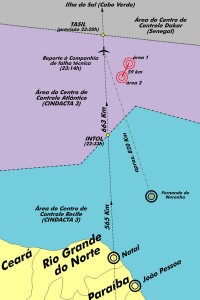 The New York Times reports that the Brazillian Minister of Defense has issued a statement that “without a doubt” the wreckage spotted by Brazillian military planes is indeed that of the missing Air France A330-200.
The New York Times reports that the Brazillian Minister of Defense has issued a statement that “without a doubt” the wreckage spotted by Brazillian military planes is indeed that of the missing Air France A330-200.
The debris included an “an orange life vest, an aircraft seat, a drum, kerosene and oil,†according to an earlier statement from the Brazilian military. It was sighted about 600 miles off Brazil’s northeastern coast and about 400 miles northeast of the Brazilian island of Fernando do Noronha roughly along the plane’s scheduled flight path.
Brazilian Navy ships are not expected to arrive at the area until Wednesday to retrieve the debris, but three commercial ships in the vicinity were helping with the search. There is no reported sign of life.
The highly experienced pilot, a 58-year-old Frenchman, had clocked 11,000 flying hours, including 1,100 hours on Airbus 330 jets, and the two co-pilots, also French, were 37 and 32 years old, and both had thousands of flight hours in Airbus A330s. Experts are currently at a loss as to how such a catastrophe could have occurred.
If the electrical malfunction that was reported by the plane’s automation to Air France was a short-circuit, for example, the cause of the crash could be an electrical fire, such as the one that caused Swissair Flight 111 to crash off the coast of Halifax in 1998.
The Airbus is a “fly by wire” plane, in which flight controls are electric, rather than hydraulic…a feature that gave it a competing edge over Boeing when it was introduced. The feature is actually considered a good one, as the system can take action to prevent a crash. Information on the Fly-By-Wire system Airbus uses can be found on their website…here. The biggest sale point of the feature was that it allowed pilots a common experience, no matter what size Airbus they were operating, allowing significant reductions in training.
However, it has been criticized, as some of the jets do not permit a pilot to override it in the event of erroneous data. On two Qantas jets last year, faulty information was sent by the inertia sensors into the flight computers, causing the aircraft to dive in response to a situation that didn’t actually exist. It has been theorized this might have something to do with this crash.
Boeing, by comparison, has a series of differing cockpits on its planes. It has implemented a similar system on the 777 and the upcoming 787, but the major philosophical difference between the two aircraft manufacturers is that Boeing builds its systems to allow pilots to override onboard computers and their preprogrammed limits, while Airbus imposes limits that cannot be overridden. The remaining Boeing aircraft, including the latest generation of the 737, the 737NG, use a more traditional fly-by-cable system, although they do have some digital safety precautions.
Did this feature contribute to whatever problems occurred? Speculation is still premature. We will continue to monitor the situation as news becomes available, and provide information on the speculations of experts and other bloggers. The New York Times has a roundup on what bloggers are saying online.
Related articles by Zemanta
- Air France plane: Brazilian military finds wreckage 400 miles off coast (telegraph.co.uk)
- French air crash: Race to find black boxes from Air France flight (telegraph.co.uk)
- Ships still hours away from possible Air France site (nationalpost.com)
- Seats among airplane debris (thestar.com)
- No signs of life in Atlantic debris (msnbc.msn.com)
![Reblog this post [with Zemanta]](http://img.zemanta.com/reblog_e.png?x-id=fee71b39-46f7-40d3-b97f-ca61afbba445)